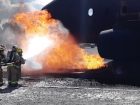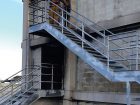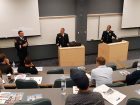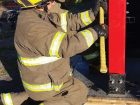
Training and Teaching
Jayson Koblun
Features TrainingCanadian Firefighter magazine held its 2018 Firefighter Training Day and Career Expo on Sept. 29 at the Fire & Emergency Services Training Institute (FESTI) in Mississauga, Ont., where current firefighters were given an opportunity to expand their skills and potential recruits learned what it takes to become one of the family.
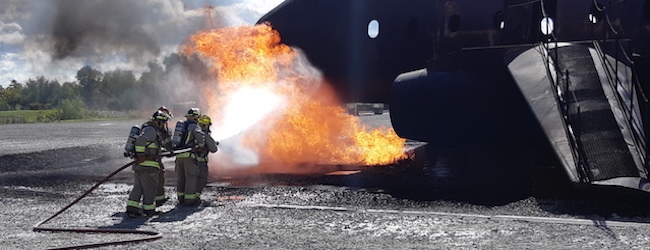 Firefighters at the 2018 Training Day participated in a course on aircraft rescue fire fighting for municipal and rural firefighters. Future firefighters learn the ropes at 2018 Career Expo
Firefighters at the 2018 Training Day participated in a course on aircraft rescue fire fighting for municipal and rural firefighters. Future firefighters learn the ropes at 2018 Career ExpoTraining Day
Roughly 130 career and volunteer firefighters attended Training Day to expand their skill sets or hone techniques on a specific aspect of fire suppression. Six “HOT courses” were offered: patient packaging and triage, live-fire rescue, forcible entry, firefighter survival, auto extrication and aircraft rescue fire fighting for municipal and rural firefighters.
Patient packaging and triage focused on instructing firefighters in medical skill sets through the use of both theoretical and practical skill stations.
Live-fire rescue refreshed firefighters’ skill sets through intense, hands-on skill stations focused on structural fire fighting.
Forcible entry started in the classroom then moved to the training ground where participants split into two groups and worked on skill development. Students worked at a forcible-entry prop, learning to breach inward and outward swinging doors. Each firefighter had the opportunity to complete both breaches. They practised forcible-entry skills using a chain saw and a rescue saw.
Firefighter survival focused on teaching firefighters how to keep themselves and their partners safe during internal fire fighting operations.
Auto extrication was staged at FESTI’s spacious auto-extrication area. The course focused on developing skill sets needed to safely and successfully mitigate a variety of challenging scenarios, including multi-vehicle collisions and extrication involving hydro poles and heavy equipment such as buses and tractor trailers.
Aircraft rescue fire fighting for municipal and rural firefighters offered fundamental knowledge and skill training needed to perform basic aircraft rescue fire fighting if called to respond to an aircraft emergency. The program consisted of theoretical and practical components. The theory instruction was presented by certified ARFF instructors and covered: response procedures, full turnout gear and SCBA, fire control, rescue operations, fire extinguishment, interior fire fighting, overhaul, and introduction to aircraft rescue fire fighting vehicles. The session focused primarily on developing hands-on skills by responding to multiple live-fire scenarios using both large and small aircraft mock-ups.
During the courses, students practiced: how to position apparatus, how to conduct exterior and interior search and rescue, handle specific handline operations, communicate on the fire ground, and how to extinguish wheel, auxiliary power unit, three-dimensional and engine fires.
A team of trained industry professionals was in charge of leading and teaching the students. The team consisted of: Capt. Randy Fleming who began his firefighting career with the Flamborough Volunteer Fire Department in 1994, Division Chief Rob Lenders who started his career with the Canadian Armed Forces (CAF) in 1985, Capt. Daniel Beaudoin who started his firefighting career with the CAF in 1981, Capt. Theresa Marinier who started her medical career with the CAF in 1990, Capt. Jean-Francois Rousseau who enrolled in the CAF in 1993, and Capt. Shawn Mainville who attended Lambton College for Fire Science Technology in 2003 and graduated on the Dean’s Honours List in 2006.
At the end of the day, students received certificates of achievement from Canadian Firefighter magazine to show they completed the courses they’d signed up for.
Career Expo
The Career Expo taught individuals who are considering becoming a firefighter how to be better prepared for tests and interviews and deal with the stresses of being a firefighter. About 40 attended.
The individuals attended a series of learning sessions, spent time networking and learned resume-building tips. They also attended mock interviews conducted by Chief Neil Main of Cambridge Fire Department, Chief Dave Pratt of Milton Fire Department and Deputy Fire Chief David Lane of FESTI.
Three individuals volunteered to participate in the mock interviews and questions were asked by Kory Pearn, a firefighter from St. Thomas. Afterwards, the chiefs gave each individual a rating. After each question, the chiefs explained what the participants did correctly or slipped up on.
Some of the questions asked by Pearn were: What do you think a firefighter does on a typical day? How will your work experience, skills and pastimes help you in the fire service? Share an example of a time you had difficulty getting along with someone and how you worked through that experience.
The session topics covered were: how to think like a fire department, why candidate testing is important, what a day in the life of a firefighter looks like, where the fire service is headed and how to succeed in it, and hiring opportunities and recruitment. A panel of chiefs also discussed firefighter expectations.
Richard Boyes, executive director of the Ontario Association of Fire Chiefs, took time to discuss the steps firefighter hopefuls should consider before committing to spending the money and time trying it out. He also reviewed new testing standards and how recruits should be prepared for tests.
Boyes spoke on the importance of candidate testing and shared questions that firefighters should ask themselves before spending money on school or training, such as: Do I even have sufficient eyesight to be a firefighter? Can I handle the sight of blood and dead bodies? Am I prepared for the mental strain this career will put on me and those close to me?
As Boyes noted, “Someone may spend thousands of dollars on school, training and equipment and not know that their vision isn’t up to firefighter standards until it’s too late.”
Or, he said, “they thought they could handle some of the gruesome details of the job, but were mistaken.”
Print this page
